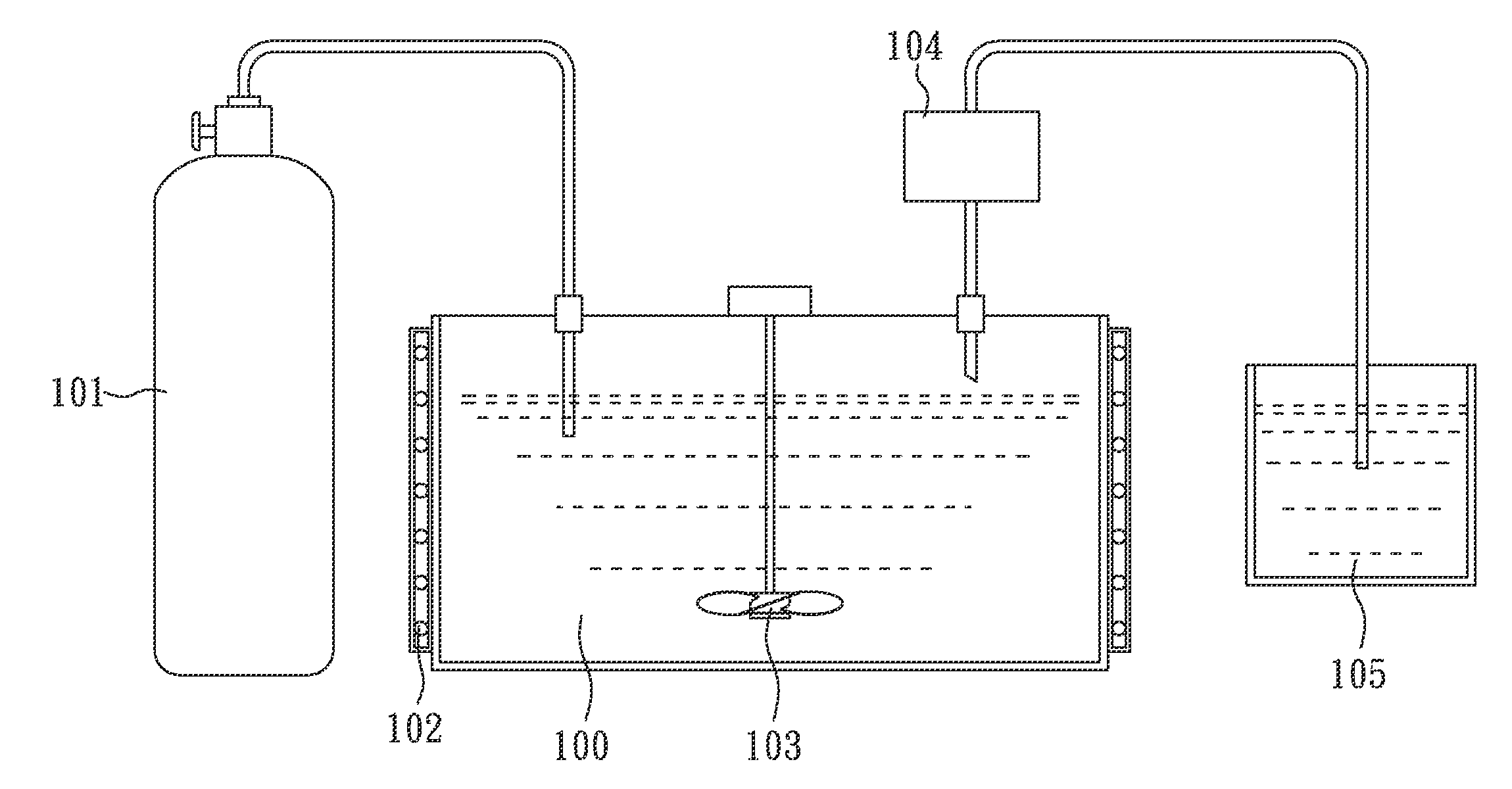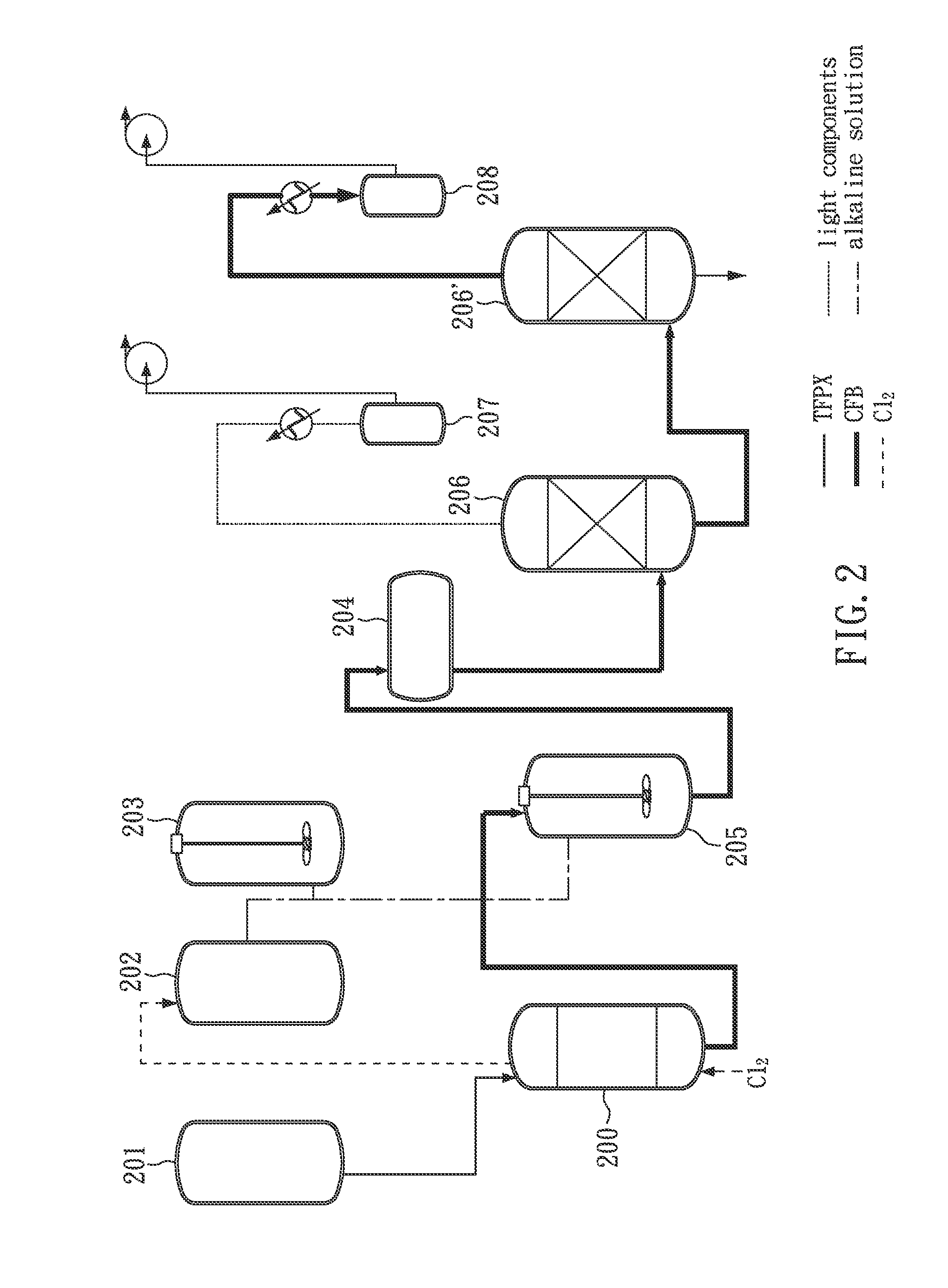Facile and effective method of preparing 1,4-bis(chlorodifluoromethyl)benzene
a technology of chlorodifluoromethyl and benzene, which is applied in the field of synthesizing 1, 4bis (chlorodifluoromethyl) benzene, can solve the problems of long reaction time, low yield, and not eco-friendly
- Summary
- Abstract
- Description
- Claims
- Application Information
AI Technical Summary
Benefits of technology
Problems solved by technology
Method used
Image
Examples
example 1
[0040]First, 300 g (1.69 mole) of TFPX is added into a glass reactor and stirred evenly by a stirrer. Subsequently, TFPX in the glass reactor is heated to 60° C., by hot water (jacket heating) and irradiated with a mercury-vapor lamp (400 W).
[0041]At this time, slightly excessive (about 336 g; 4.73 mole) is continuously introduced into the glass reactor so as to perform chlorination. During the reaction the pressure in the glass reactor is kept slightly higher than 1 atm (about 1.01 atm), and the reaction is maintained for 45 minutes to obtain a light yellow liquid. Then, the light yellow liquid (GC purity: 99.32%) is neutralized by an alkaline solution and treated with oil-water phase separation, followed by distillation under a pressure of 10 torr at 125° C. (corresponding to the boiling point of CFB) to obtain 408 g of colorless liquid product in a yield of 98.1%.
[0042]Finally, the liquid product as described above is analyzed by GC. According to the results of GC analysis, the f...
example 2
[0043]First, 600.01 g (3.37 mole) of TFPX is added into a glass reactor and stirred evenly by a stirrer. Subsequently, TFPX in the glass reactor is heated to 60° C. by hot water (jacket heating) and irradiated with a mercury-vapor lamp (400 W).
[0044]At this time, slightly excessive Cl2 (about 600 g; 8.43 mole) is continuously introduced into the glass reactor so as to perform chlorination. During the reaction the pressure in the glass reactor is kept slightly higher than 1 atm (about 1.01 atm), and the reaction is maintained for 100 minutes to obtain a light yellow liquid.
[0045]After the steps as described above, the light yellow liquid is analyzed by GC. According to the results of GC analysis, the formation of CFB is confirmed, and the purity of CFB is 99.49%.
example 3
[0046]First, 441.90 g (2.48 mole) of TFPX is added into a glass reactor and stirred evenly by a stirrer. Subsequently, TFPX in the glass reactor is heated to 75° C. by hot water (jacket heating) and irradiated with two ultraviolet lamps (Both are 36 W).
[0047]At this time, slightly excessive Cl2 (about 580 g; 8.18 mole) is continuously introduced into the glass reactor so as to perform chlorination. During the reaction the pressure in the glass reactor is kept slightly higher than 1 atm (about 1.01 atm), and the reaction is maintained for 95 minutes to obtain a light yellow liquid.
[0048]After the steps as described above, the light yellow liquid is analyzed by GC. According to the results of GC analysis, the formation of CFB is confirmed, and the purity if CFB is 99.44%.
PUM
| Property | Measurement | Unit |
|---|---|---|
| pressure | aaaaa | aaaaa |
| temperature | aaaaa | aaaaa |
| molar ratio | aaaaa | aaaaa |
Abstract
Description
Claims
Application Information
 Login to View More
Login to View More - R&D
- Intellectual Property
- Life Sciences
- Materials
- Tech Scout
- Unparalleled Data Quality
- Higher Quality Content
- 60% Fewer Hallucinations
Browse by: Latest US Patents, China's latest patents, Technical Efficacy Thesaurus, Application Domain, Technology Topic, Popular Technical Reports.
© 2025 PatSnap. All rights reserved.Legal|Privacy policy|Modern Slavery Act Transparency Statement|Sitemap|About US| Contact US: help@patsnap.com



